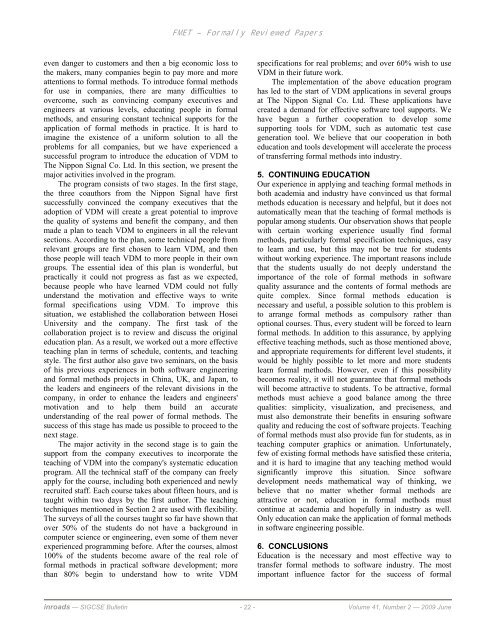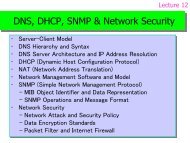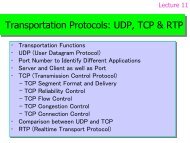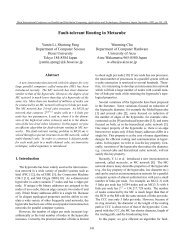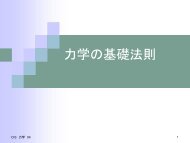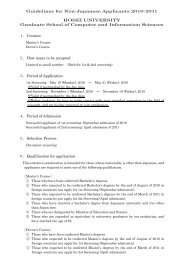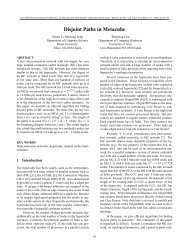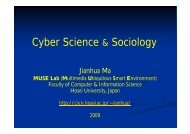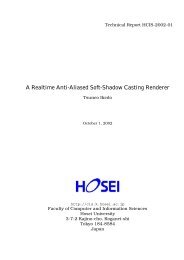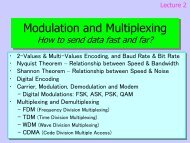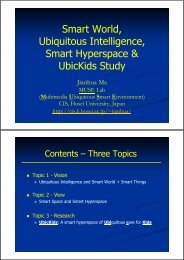Teaching formal methods in the context of software engineering
Teaching formal methods in the context of software engineering
Teaching formal methods in the context of software engineering
You also want an ePaper? Increase the reach of your titles
YUMPU automatically turns print PDFs into web optimized ePapers that Google loves.
FMET – Formally Reviewed Papers<br />
even danger to customers and <strong>the</strong>n a big economic loss to<br />
<strong>the</strong> makers, many companies beg<strong>in</strong> to pay more and more<br />
attentions to <strong>formal</strong> <strong>methods</strong>. To <strong>in</strong>troduce <strong>formal</strong> <strong>methods</strong><br />
for use <strong>in</strong> companies, <strong>the</strong>re are many difficulties to<br />
overcome, such as conv<strong>in</strong>c<strong>in</strong>g company executives and<br />
eng<strong>in</strong>eers at various levels, educat<strong>in</strong>g people <strong>in</strong> <strong>formal</strong><br />
<strong>methods</strong>, and ensur<strong>in</strong>g constant technical supports for <strong>the</strong><br />
application <strong>of</strong> <strong>formal</strong> <strong>methods</strong> <strong>in</strong> practice. It is hard to<br />
imag<strong>in</strong>e <strong>the</strong> existence <strong>of</strong> a uniform solution to all <strong>the</strong><br />
problems for all companies, but we have experienced a<br />
successful program to <strong>in</strong>troduce <strong>the</strong> education <strong>of</strong> VDM to<br />
The Nippon Signal Co. Ltd. In this section, we present <strong>the</strong><br />
major activities <strong>in</strong>volved <strong>in</strong> <strong>the</strong> program.<br />
The program consists <strong>of</strong> two stages. In <strong>the</strong> first stage,<br />
<strong>the</strong> three coauthors from <strong>the</strong> Nippon Signal have first<br />
successfully conv<strong>in</strong>ced <strong>the</strong> company executives that <strong>the</strong><br />
adoption <strong>of</strong> VDM will create a great potential to improve<br />
<strong>the</strong> quality <strong>of</strong> systems and benefit <strong>the</strong> company, and <strong>the</strong>n<br />
made a plan to teach VDM to eng<strong>in</strong>eers <strong>in</strong> all <strong>the</strong> relevant<br />
sections. Accord<strong>in</strong>g to <strong>the</strong> plan, some technical people from<br />
relevant groups are first chosen to learn VDM, and <strong>the</strong>n<br />
those people will teach VDM to more people <strong>in</strong> <strong>the</strong>ir own<br />
groups. The essential idea <strong>of</strong> this plan is wonderful, but<br />
practically it could not progress as fast as we expected,<br />
because people who have learned VDM could not fully<br />
understand <strong>the</strong> motivation and effective ways to write<br />
<strong>formal</strong> specifications us<strong>in</strong>g VDM. To improve this<br />
situation, we established <strong>the</strong> collaboration between Hosei<br />
University and <strong>the</strong> company. The first task <strong>of</strong> <strong>the</strong><br />
collaboration project is to review and discuss <strong>the</strong> orig<strong>in</strong>al<br />
education plan. As a result, we worked out a more effective<br />
teach<strong>in</strong>g plan <strong>in</strong> terms <strong>of</strong> schedule, contents, and teach<strong>in</strong>g<br />
style. The first author also gave two sem<strong>in</strong>ars, on <strong>the</strong> basis<br />
<strong>of</strong> his previous experiences <strong>in</strong> both s<strong>of</strong>tware eng<strong>in</strong>eer<strong>in</strong>g<br />
and <strong>formal</strong> <strong>methods</strong> projects <strong>in</strong> Ch<strong>in</strong>a, UK, and Japan, to<br />
<strong>the</strong> leaders and eng<strong>in</strong>eers <strong>of</strong> <strong>the</strong> relevant divisions <strong>in</strong> <strong>the</strong><br />
company, <strong>in</strong> order to enhance <strong>the</strong> leaders and eng<strong>in</strong>eers'<br />
motivation and to help <strong>the</strong>m build an accurate<br />
understand<strong>in</strong>g <strong>of</strong> <strong>the</strong> real power <strong>of</strong> <strong>formal</strong> <strong>methods</strong>. The<br />
success <strong>of</strong> this stage has made us possible to proceed to <strong>the</strong><br />
next stage.<br />
The major activity <strong>in</strong> <strong>the</strong> second stage is to ga<strong>in</strong> <strong>the</strong><br />
support from <strong>the</strong> company executives to <strong>in</strong>corporate <strong>the</strong><br />
teach<strong>in</strong>g <strong>of</strong> VDM <strong>in</strong>to <strong>the</strong> company's systematic education<br />
program. All <strong>the</strong> technical staff <strong>of</strong> <strong>the</strong> company can freely<br />
apply for <strong>the</strong> course, <strong>in</strong>clud<strong>in</strong>g both experienced and newly<br />
recruited staff. Each course takes about fifteen hours, and is<br />
taught with<strong>in</strong> two days by <strong>the</strong> first author. The teach<strong>in</strong>g<br />
techniques mentioned <strong>in</strong> Section 2 are used with flexibility.<br />
The surveys <strong>of</strong> all <strong>the</strong> courses taught so far have shown that<br />
over 50% <strong>of</strong> <strong>the</strong> students do not have a background <strong>in</strong><br />
computer science or eng<strong>in</strong>eer<strong>in</strong>g, even some <strong>of</strong> <strong>the</strong>m never<br />
experienced programm<strong>in</strong>g before. After <strong>the</strong> courses, almost<br />
100% <strong>of</strong> <strong>the</strong> students become aware <strong>of</strong> <strong>the</strong> real role <strong>of</strong><br />
<strong>formal</strong> <strong>methods</strong> <strong>in</strong> practical s<strong>of</strong>tware development; more<br />
than 80% beg<strong>in</strong> to understand how to write VDM<br />
specifications for real problems; and over 60% wish to use<br />
VDM <strong>in</strong> <strong>the</strong>ir future work.<br />
The implementation <strong>of</strong> <strong>the</strong> above education program<br />
has led to <strong>the</strong> start <strong>of</strong> VDM applications <strong>in</strong> several groups<br />
at The Nippon Signal Co. Ltd. These applications have<br />
created a demand for effective s<strong>of</strong>tware tool supports. We<br />
have begun a fur<strong>the</strong>r cooperation to develop some<br />
support<strong>in</strong>g tools for VDM, such as automatic test case<br />
generation tool. We believe that our cooperation <strong>in</strong> both<br />
education and tools development will accelerate <strong>the</strong> process<br />
<strong>of</strong> transferr<strong>in</strong>g <strong>formal</strong> <strong>methods</strong> <strong>in</strong>to <strong>in</strong>dustry.<br />
5. CONTINUING EDUCATION<br />
Our experience <strong>in</strong> apply<strong>in</strong>g and teach<strong>in</strong>g <strong>formal</strong> <strong>methods</strong> <strong>in</strong><br />
both academia and <strong>in</strong>dustry have conv<strong>in</strong>ced us that <strong>formal</strong><br />
<strong>methods</strong> education is necessary and helpful, but it does not<br />
automatically mean that <strong>the</strong> teach<strong>in</strong>g <strong>of</strong> <strong>formal</strong> <strong>methods</strong> is<br />
popular among students. Our observation shows that people<br />
with certa<strong>in</strong> work<strong>in</strong>g experience usually f<strong>in</strong>d <strong>formal</strong><br />
<strong>methods</strong>, particularly <strong>formal</strong> specification techniques, easy<br />
to learn and use, but this may not be true for students<br />
without work<strong>in</strong>g experience. The important reasons <strong>in</strong>clude<br />
that <strong>the</strong> students usually do not deeply understand <strong>the</strong><br />
importance <strong>of</strong> <strong>the</strong> role <strong>of</strong> <strong>formal</strong> <strong>methods</strong> <strong>in</strong> s<strong>of</strong>tware<br />
quality assurance and <strong>the</strong> contents <strong>of</strong> <strong>formal</strong> <strong>methods</strong> are<br />
quite complex. S<strong>in</strong>ce <strong>formal</strong> <strong>methods</strong> education is<br />
necessary and useful, a possible solution to this problem is<br />
to arrange <strong>formal</strong> <strong>methods</strong> as compulsory ra<strong>the</strong>r than<br />
optional courses. Thus, every student will be forced to learn<br />
<strong>formal</strong> <strong>methods</strong>. In addition to this assurance, by apply<strong>in</strong>g<br />
effective teach<strong>in</strong>g <strong>methods</strong>, such as those mentioned above,<br />
and appropriate requirements for different level students, it<br />
would be highly possible to let more and more students<br />
learn <strong>formal</strong> <strong>methods</strong>. However, even if this possibility<br />
becomes reality, it will not guarantee that <strong>formal</strong> <strong>methods</strong><br />
will become attractive to students. To be attractive, <strong>formal</strong><br />
<strong>methods</strong> must achieve a good balance among <strong>the</strong> three<br />
qualities: simplicity, visualization, and preciseness, and<br />
must also demonstrate <strong>the</strong>ir benefits <strong>in</strong> ensur<strong>in</strong>g s<strong>of</strong>tware<br />
quality and reduc<strong>in</strong>g <strong>the</strong> cost <strong>of</strong> s<strong>of</strong>tware projects. <strong>Teach<strong>in</strong>g</strong><br />
<strong>of</strong> <strong>formal</strong> <strong>methods</strong> must also provide fun for students, as <strong>in</strong><br />
teach<strong>in</strong>g computer graphics or animation. Unfortunately,<br />
few <strong>of</strong> exist<strong>in</strong>g <strong>formal</strong> <strong>methods</strong> have satisfied <strong>the</strong>se criteria,<br />
and it is hard to imag<strong>in</strong>e that any teach<strong>in</strong>g method would<br />
significantly improve this situation. S<strong>in</strong>ce s<strong>of</strong>tware<br />
development needs ma<strong>the</strong>matical way <strong>of</strong> th<strong>in</strong>k<strong>in</strong>g, we<br />
believe that no matter whe<strong>the</strong>r <strong>formal</strong> <strong>methods</strong> are<br />
attractive or not, education <strong>in</strong> <strong>formal</strong> <strong>methods</strong> must<br />
cont<strong>in</strong>ue at academia and hopefully <strong>in</strong> <strong>in</strong>dustry as well.<br />
Only education can make <strong>the</strong> application <strong>of</strong> <strong>formal</strong> <strong>methods</strong><br />
<strong>in</strong> s<strong>of</strong>tware eng<strong>in</strong>eer<strong>in</strong>g possible.<br />
6. CONCLUSIONS<br />
Education is <strong>the</strong> necessary and most effective way to<br />
transfer <strong>formal</strong> <strong>methods</strong> to s<strong>of</strong>tware <strong>in</strong>dustry. The most<br />
important <strong>in</strong>fluence factor for <strong>the</strong> success <strong>of</strong> <strong>formal</strong><br />
<strong>in</strong>roads — SIGCSE Bullet<strong>in</strong> - 22 - Volume 41, Number 2 — 2009 June


